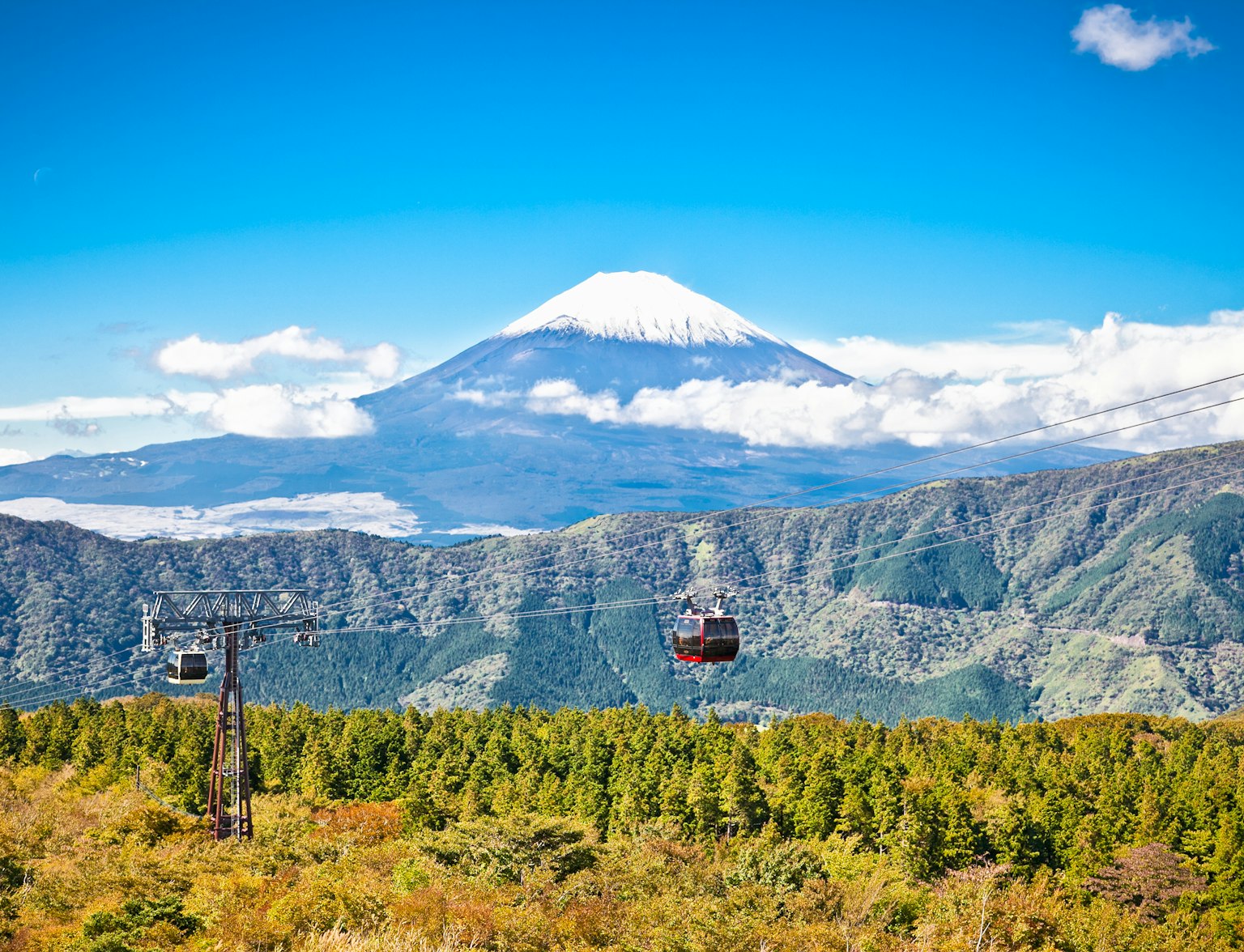

ภูเขาไฟฟูจิเป็นหนึ่งในสถานที่สําคัญที่มีชื่อเสียงที่สุดของญี่ปุ่น และไม่น่าแปลกใจเลยที่ผู้คนจํานวนมากต้องการชมภูเขาไฟฟูจิอย่างใกล้ชิด ตั้งแต่ทิวทัศน์อันน่าทึ่งไปจนถึงทะเลสาบอันเงียบสงบโดยรอบ
แต่การเยี่ยมชมภูเขาไฟฟูจิไม่จําเป็นต้องเสียค่าใช้จ่ายมากมาย กิจกรรมฟรี และอาหารและที่พักราคาประหยัด คุณจะได้สัมผัสกับจุดที่เป็นสัญลักษณ์แห่งนี้โดยไม่ต้องใช้จ่ายมากเกินไป
คู่มือนี้จะแสดงวิธีการวางแผน ทริปภูเขาไฟฟูจิ ในงบประมาณในขณะที่ใช้เวลาให้เกิดประโยชน์สูงสุดจากที่นั่น

ภูเขาไฟฟูจิตั้งอยู่ที่ความสูง 3,776 เมตร เป็นยอดเขาที่สูงที่สุดในญี่ปุ่น เป็นภูเขาไฟที่ยังคุกรุ่น แม้ว่าจะไม่ได้ปะทุมาตั้งแต่ปี 1707 และปัจจุบันได้รับการยอมรับให้เป็นมรดกโลกขององค์การยูเนสโก ภูเขาและพื้นที่โดยรอบ รวมถึง ทะเลสาบฟูจิทั้งห้านําเสนอทิวทัศน์ที่น่าทึ่งการผจญภัยกลางแจ้งและประสบการณ์ทางวัฒนธรรม
สําหรับนักเดินทางที่มีงบประมาณจํากัด ภูเขาไฟฟูจิเป็นจุดหมายปลายทางที่ยอดเยี่ยมเพราะให้การผสมผสานระหว่างธรรมชาติ การผ่อนคลาย และการผจญภัยโดยไม่ทําลายธนาคาร ไม่ว่าคุณจะชอบเดินป่า เที่ยวชมสถานที่ หรือเพียงแค่ดื่มด่ํากับทิวทัศน์ ก็มีบางสิ่งสําหรับทุกคน
รถบัสเป็นตัวเลือกที่เป็นมิตรกับงบประมาณมากที่สุดสําหรับการเยี่ยมชมภูเขาไฟฟูจิ คุณสามารถขึ้นรถบัสตรงจากโตเกียวไปยังพื้นที่ต่างๆ เช่น คาวากุจิโกะ หรือสถานีฟูจิซูบารุที่ 5 ซึ่งเป็นจุดเริ่มต้นของนักปีนเขาส่วนใหญ่

เพลิดเพลินไปกับทริปหนึ่งวันแสนสนุกจากโตเกียวไปยังภูเขาไฟฟูจิและฮาโกเน่
ค่า: ตั๋วไปกลับโดยทั่วไปมีราคาระหว่าง 3,600 ถึง 4,500 เยน
เวลาเดินทาง: ประมาณสองชั่วโมง
ขึ้นรถบัสได้ที่ไหน: รถบัสไปยังภูเขาไฟฟูจิออกเดินทางจากสถานที่สําคัญ เช่น สถานีชินจูกุหรือสถานีโตเกียว บริษัทรถบัสหลายแห่งให้บริการในเส้นทางเหล่านี้ คุณจึงสามารถเปรียบเทียบราคาและตารางเวลาได้
รถไฟมีราคาแพงกว่ารถประจําทางเล็กน้อย แต่ให้ความสะดวกสบายและเวลาเดินทางที่เร็วขึ้นสําหรับบางเส้นทาง หากต้องการเยี่ยมชมภูเขาไฟฟูจิ คุณอาจต้องเปลี่ยนจากสถานี Otsuki ไปยัง ฟูจิคิวเรลเวย์ซึ่งจะพาคุณไปยังสถานีคาวากุจิโกะ

ค้นพบญี่ปุ่นอย่างไร้ขีดจํากัดด้วย JR Pass ที่เข้าถึงได้ทั้งหมดของเรา!
ค่า: ประมาณ 4,130 เยนต่อเที่ยว
เวลาเดินทาง: ประมาณสองชั่วโมงกับการโอนครั้งเดียว
เคล็ด ลับ: หากคุณเป็นผู้ถือบัตร Japan Rail Pass จะครอบคลุมสาย JR ไปยังโอสึกิ แต่คุณจะต้องชําระแยกต่างหากสําหรับรถไฟฟูจิคิว
การเช่ารถเป็นอีกทางเลือกหนึ่ง โดยเฉพาะอย่างยิ่งหากคุณเดินทางเป็นกลุ่ม การขับรถไปยังภูเขาไฟฟูจิช่วยให้คุณมีอิสระในการสํารวจตามอัธยาศัย รวมถึงพื้นที่ที่ไม่สามารถเข้าถึงได้ง่ายด้วยระบบขนส่งสาธารณะ

เพลิดเพลินไปกับทัวร์ภูเขาไฟฟูจิแบบส่วนตัวเต็มวันด้วยรถพรีเมียม
ค่า: ราคาเช่าแตกต่างกันไป แต่รถธรรมดาเริ่มต้นที่ประมาณ 5,000 เยนต่อวัน ค่าแก๊สและค่าผ่านทางควรรวมอยู่ในงบประมาณของคุณ
เวลาเดินทาง: ประมาณสองชั่วโมงยี่สิบนาที
สิทธิพิเศษ: ความยืดหยุ่นในการเยี่ยมชมจุดซ่อนเร้นและพื้นที่ชมวิวระหว่างทาง
พื้นที่ภูเขาไฟฟูจิเต็มไปด้วยกิจกรรมที่รองรับนักเดินทางทุกประเภท นี่คือไฮไลท์บางส่วนที่จะไม่ทําให้กระเป๋าเงินของคุณเครียด:

ทะเลสาบฟูจิทั้งห้า ได้แก่ คาวากุจิ ไซโกะ ยามานากะ โชจิ และโมโตสุ ตั้งอยู่ที่ฐานภูเขาไฟฟูจิทางตอนเหนือ ทะเลสาบแต่ละแห่งมอบประสบการณ์ที่ไม่เหมือนใคร เช่น การพายเรือ ตกปลา และเส้นทางเดิน
ตัวเลือกที่ดีที่สุดสําหรับนักเดินทางที่มีงบประมาณจํากัด: ทะเลสาบคาวากุจิเป็นทะเลสาบที่มีการพัฒนามากที่สุดและมีการเชื่อมต่อการขนส่งที่ดีที่สุด การเดินเล่นไปตามชายฝั่งและเพลิดเพลินกับทิวทัศน์นั้นฟรีโดยสมบูรณ์
ต้น ทุน: ค่าเช่าเรือหรือกิจกรรมต่างๆ เช่น ตกปลา มักจะมีราคาระหว่าง 1,000 ถึง 3,000 เยน
เจดีย์ห้าชั้นแห่งนี้เป็นยอด จุดถ่ายรูปภูเขาไฟฟูจิ. เป็นส่วนหนึ่งของสวนอาราคุรายามะ เซนเก็น ซึ่งเปิดให้เข้าชมฟรี การปีนขึ้นบันไดระยะสั้นจะให้รางวัลแก่คุณด้วยทิวทัศน์ที่โด่งดังที่สุดแห่งหนึ่งของภูเขา
ค่า:ฟรี
ปลาย: เยี่ยมชมในตอนเช้าตรู่หรือบ่ายแก่ๆ เพื่อหลีกเลี่ยงฝูงชนและรับแสงที่ดีที่สุด
สระน้ําใสราวคริสตัล 8 แห่งนี้ได้รับอาหารจากหิมะที่ละลายของภูเขาไฟฟูจิ สระน้ําล้อมรอบด้วยร้านค้าเล็กๆ ที่ขายขนมและของที่ระลึกในท้องถิ่น ทําให้เป็นจุดแวะพักที่น่ารื่นรมย์สําหรับนักเดินทางที่มีงบประมาณจํากัด
ค่า: อิสระที่จะเดินไปรอบ ๆ ค่าธรรมเนียมเล็กน้อยสําหรับขนมขบเคี้ยวหรือของที่ระลึก

เพลิดเพลินไปกับทริปเต็มวันจากโตเกียวไปยังภูเขาไฟฟูจิ
หากคุณมาเยือนในช่วงฤดูปีนเขา (กรกฎาคมถึงกันยายน) การเดินป่าภูเขาไฟฟูจิ สามารถเป็นประสบการณ์ราคาไม่แพงและน่าจดจํา สําหรับผู้ที่ไม่ได้ปีนเขา ยังมีเส้นทางที่ง่ายกว่ารอบฐานเขา
ค่าใช้จ่ายในการปีนเขา: ไม่มีค่าใช้จ่ายในการปีนภูเขาไฟฟูจิ แต่สนับสนุนให้บริจาค (ประมาณ 1,000 เยน) เพื่อสนับสนุนความพยายามในการอนุรักษ์
การเดินป่าแบบไปเช้าเย็นกลับ: เส้นทางอย่าง Yoshida Trail เริ่มต้นจากสถานีที่ 5 และสามารถทําได้โดยไม่ต้องไปถึงยอดเขา
หลังจากสํารวจมาทั้งวัน การผ่อนคลายในบ่อน้ําพุร้อนหรือออนเซ็นเป็นวิธีที่สมบูรณ์แบบในการผ่อนคลาย ออนเซ็นหลายแห่งใกล้กับภูเขาไฟฟูจิมีทิวทัศน์ของภูเขาไฟ
ต้น ทุน: ค่าเข้าชมมักจะอยู่ระหว่าง 500 ถึง 1,500 เยน
เคล็ดลับงบประมาณ: มองหาโรงอาบน้ําสาธารณะหรือออนเซ็นขนาดเล็กสําหรับตัวเลือกที่ราคาไม่แพงกว่า
สวนสนุกแห่งนี้มีเครื่องเล่นที่น่าตื่นเต้นพร้อมทิวทัศน์ของภูเขาไฟฟูจิ เป็นตัวเลือกที่ยอดเยี่ยมสําหรับครอบครัวหรือผู้แสวงหาการผจญภัย
ต้น ทุน: ค่าเข้าชมเริ่มต้นที่ประมาณ 1,500 เยนสําหรับค่าเข้าชม โดยมีค่าใช้จ่ายเพิ่มเติมสําหรับการนั่งแต่ละครั้ง

ทําให้การเยี่ยมชม Fuji-Q Highland ของคุณไม่ยุ่งยากด้วยตั๋วอิเล็กทรอนิกส์
อาหารรอบภูเขาไฟฟูจิไม่จําเป็นต้องมีราคาแพง ต่อไปนี้คือตัวเลือกที่เป็นมิตรกับงบประมาณ:
ของว่างท้องถิ่น: ลองชิมยากิดังโงะ (เกี๊ยวข้าวย่าง) ไทยากิ (ขนมอบรูปปลาสอดไส้ถั่วแดงหวาน) หรือข้าวโพดซังที่ขายจากพ่อค้าแม่ค้าริมถนน
ร้านอาหารสบาย ๆ: อาหารง่ายๆ เช่น แกงกะหรี่และข้าว หรือราเม็งชามมักจะมีราคาระหว่าง 500 ถึง 1,000 เยน
ปิกนิก: ซื้ออาหารจากร้านสะดวกซื้อในโตเกียวก่อนออกเดินทาง โอนิกิริ (ข้าวปั้น) แซนวิช และกล่องเบนโตะมีราคาไม่แพงและพกพาสะดวก
เดินทางนอกช่วงพีค: การเยี่ยมชมในช่วงวันธรรมดาหรือฤดูกาลไหล่ (เมษายน-พฤษภาคม หรือตุลาคม-พฤศจิกายน) สามารถช่วยให้คุณประหยัดค่าเดินทางและที่พักได้
ใช้บัตรส่วนลด: มองหาบัตรโดยสารระดับภูมิภาค เช่น JR Tokyo Wide Pass ซึ่งรวมถึงการเดินทางด้วยรถไฟไปยังภูเขาไฟฟูจิและพื้นที่โดยรอบ
แพ็คขนมขบเคี้ยว: การนําขนมหรือเครื่องดื่มจากโตเกียวมาช่วยประหยัดเงินเมื่อเทียบกับการซื้อที่สถานที่ท่องเที่ยว
จองล่วงหน้า: จองตั๋วรถบัสและที่พักแต่เนิ่นๆ เพื่อรับข้อเสนอที่ดีที่สุด
การเดินทางประหยัดไปยังภูเขาไฟฟูจิสามารถให้รางวัลและจัดการได้หากคุณมุ่งเน้นไปที่ตัวเลือกที่ขับเคลื่อนด้วยคุณค่า เลือกใช้รถบัสหรือรถไฟเพื่อประหยัดค่าขนส่ง สํารวจสถานที่ท่องเที่ยวทางธรรมชาติ เช่น ทะเลสาบฟูจิทั้งห้าและเจดีย์ชูเรโตะ และใช้ประโยชน์จากที่พักราคาไม่แพง เช่น โฮสเทลหรือที่ตั้งแคมป์ จับคู่กับอาหารราคาถูกและกิจกรรมฟรีเพื่อสร้างประสบการณ์ที่น่าจดจํา
การวางแผนอย่างชาญฉลาดไม่เพียงแต่ขยายงบประมาณของคุณ แต่ยังช่วยให้คุณได้สัมผัสกับสิ่งที่พื้นที่นําเสนอมากขึ้น ด้วยข้อมูลเชิงลึกเหล่านี้ คุณก็พร้อมที่จะ เพลิดเพลินไปกับภูเขาไฟฟูจิ โดยไม่ลดทอนคุณภาพ
การปีนภูเขาไฟฟูจิมีราคาแพงหรือไม่?
การปีนภูเขาไฟฟูจิมีราคาไม่แพงนัก ไม่มีค่าธรรมเนียมภาคบังคับ แต่ขอแนะนําให้บริจาคเงิน 1,000 เยนเพื่อสนับสนุนความพยายามในการอนุรักษ์ ค่าใช้จ่ายส่วนใหญ่รวมถึงการเดินทาง อุปกรณ์ และที่พักกระท่อมบนภูเขา
ไปเที่ยวภูเขาไฟฟูจิในราคาประหยัดช่วงไหนดี?
การเยี่ยมชมในช่วงนอกฤดูท่องเที่ยว เช่น เมษายน-พฤษภาคม หรือตุลาคม-พฤศจิกายน จะช่วยหลีกเลี่ยงราคาค่าขนส่งและที่พักที่สูงขึ้น โดยทั่วไปแล้ววันธรรมดาจะมีราคาถูกกว่าวันหยุดสุดสัปดาห์
มีค่าใช้จ่ายแอบแฝงเมื่อไปเยือนภูเขาไฟฟูจิหรือไม่?
ค่าใช้จ่ายเพิ่มเติมที่ควรคํานึงถึง ได้แก่ ค่าจอดรถหากขับรถ การเข้าพักในกระท่อมบนภูเขา (6,000-8,000 เยนต่อคืน) และค่าธรรมเนียมเล็กน้อยสําหรับห้องน้ําสาธารณะ (200 เยนในบางพื้นที่) การวางแผนล่วงหน้าสามารถช่วยให้คุณหลีกเลี่ยงความประหลาดใจได้
ฉันสามารถใช้ Japan Rail Pass เพื่อเยี่ยมชมภูเขาไฟฟูจิได้หรือไม่?
Japan Rail Pass ครอบคลุมการเดินทางบนสาย JR ไปยังสถานี Otsuki แต่รถไฟ Fujikyu Railway จากโอสึกิไปยังคาวากุจิโกะต้องใช้ตั๋วแยกต่างหาก ตัวเลือกนี้ยังคงคุ้มค่าสําหรับผู้ถือบัตรโดยสารรถไฟ



